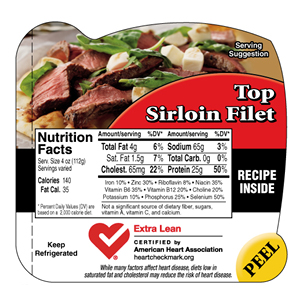
|
Retailers who harness the significance of nutrition information in the meat case can turn labeling into a very powerful marketing tool to build customer loyalty and increase fresh meat sales.
As you develop your meat case nutrition-labeling program in preparation for the Jan. 1, 2012, implementation date, we strive to be your most valuable resource in determining compliance requirements and developing a program that delivers, through an effective communications platform, the nutritional information your customers desire and need in order to make purchasing decision for optimal health.
The Beef Checkoff has conducted extensive research in an effort to understand consumers’ preferences when it comes to nutrition labeling for meat. This research shows that a meat case labeling program that follows these guidelines will increase customer loyalty and meat sales. With this research in mind, let’s outline the best practices that will help you effectively deliver a meat case nutrition-labeling program that will meet your customer’s needs.
Whether on-pack or at the point of purchase, communicate fresh meat’s complete nutrition package — Three out of four consumers indicate they prefer a label that includes additional relevant vitamins and minerals found in meat and poultry1. The micronutrients found in meat, other than the required iron, (e.g., zinc, B vitamins, riboflavin, etc.) can be listed either in addition to or in place of the required vitamins and minerals as long as the “Not a significant source …” statement is used.
Relevance, relevance, relevance — Provide your customers with nutrition information that is relevant to how they consume the product, using “as consumed” nutrient data. The more relevant nutrition information puts fresh meat products in a more positive light and therefore can result in increased sales.
Use “Dual Declaration” labels to incorporate “as consumed” data on ground beef labels
If no nutrition claims are made for whole-muscle products, use “as consumed” data along with appropriate preparation and cooking instructions. The additional information will help ensure your customers are consistently preparing your product to deliver a great eating experience for their families.
Amplify nutrition labeling as a merchandising tool — Your customers not only want to know the nutritional content of their beef/meat, but they also want to know what its nutrients provide for their health and the health of their family. There are long-term gains to be made by developing an on-pack nutrition-labeling program that includes declarations that help guide your customers to healthy meat selections.
POS is critical — An on-pack nutrition labeling program allows you to extend the promotion of positive claims about beef and its nutritional benefits to point-of-sale (POS) materials to grab customers’ attention and generate a “lift” in sales.
The more opportunities you use to promote the nutritional information you’re providing on your beef and meat products to your customers, the more recognition they will give you for making this information available to them.
Our research shows that providing this information to consumers can increase customer loyalty and purchase intent. Use these programs to build your customer’s commitment to you and in turn, your meat department sales.
Cheryl Hendricks is a registered dietitian with the National Cattlemen’s Beef Association (NCBA), which contracts to manage retail marketing efforts for The Beef Checkoff.




Report Abusive Comment